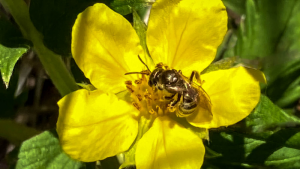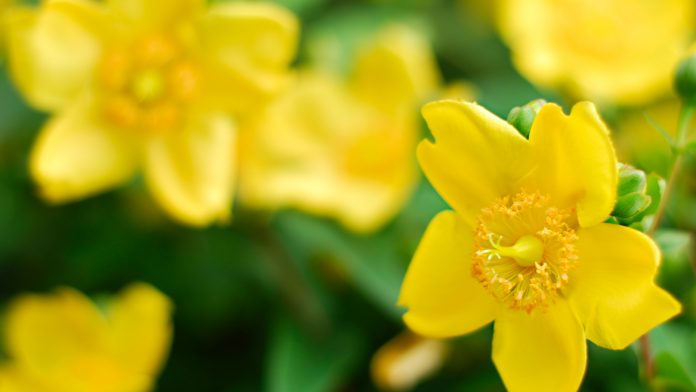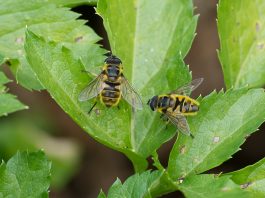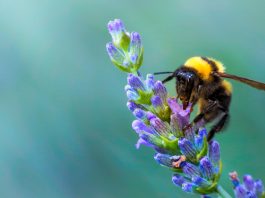Different substances that are invisible to the human eye and found in the petals of flowers, attract insects with a ‘bulls-eye’ that is the key to pollination survival.
According to scientists at Clemson University, the different invisible substances found in the petals of flowers create a ‘bulls-eye’ that attracts pollinating insects. A new research study, led by Mattahew Koski, an assistant professor of biological sciences in the Clemson College of Science, studied the bright, yellow flowers of Argentina anserina — a member of the rose family commonly known as silverweed. His study forefronts the chemical changes in flowers that aids them to respond to environmental changes, including climate change, that might threaten pollination survival.
Koski chose to analyse the silverweed flower to learn how pigments in the petals that are visible only within the ultraviolet spectrum play an integral part in the plant’s plasticity and ability to quickly respond to a changing environment. The research team also included Clemson researchers Lindsay Finnell, Elizabeth Leonard and Nishanth Tharayil. The journal Evolution featured the findings on the cover of its March edition.
UV-absorbing chemicals in the plants’ petals
The researchers studied silverweed growing at different elevations in Southwestern Colorado to better understand the roles of the various UV-absorbing chemicals in the plants’ petals, and how these chemicals work to aid in pollination and, thus, reproduction. Koski explained that although humans cannot see the UV patterns on the flower’s petals, many of its pollinators can.
“I’ve always been fascinated with how [colour variation of flowers] arises, how it evolves and what factors drive the evolution of colour variation,” explained Koski. “I got interested in thinking about how we perceive colour versus how the organisms that interact more frequently with flowers perceive colour.
“Insects — pollinators, for example—see in the ultraviolet spectrum. So, flowers that reflect or absorb ultraviolet wavelengths give (to pollinators) the perception of different colours that we cannot see. I have been fascinated with uncovering what these UV signals might be doing functionally with respect to pollination. When I thought about the trait of interest in ultraviolet absorption, it is biochemistry. It is a biochemical trait that leads to different perceptions of UV absorption and reflectance.”
A large collection of plants has concentrations of UV-absorbing chemicals at the base of the flower’s petals, while the tips of the petals have more UV-reflecting chemicals. This creates a ‘bulls-eye’ effect that guides insects in their search for pollen.

How plants adapt to their environments
The research team sought to uncover more about how the plants adapt to different environments – specifically how they adapt to a difference in altitude of 1,000 metres. They discovered that flowers at different altitudes adapt to their environments by producing varying amounts of UV-blocking or UV-absorbing chemicals.
“At higher elevations, there are always more UV-absorbing compounds or larger spatial area of UV absorption on the petals, compared to the low-elevation populations,” Koski explained.
The researchers stated that this demonstrates the plant’s plasticity, and how differing traits arise in the same organisms under different environmental conditions and constraints. This is a critical step in understanding how organisms adapt to survive change.
“What is important about plasticity is, when we think about climate change and global change, plasticity is one mechanism by which natural populations can respond really rapidly to changing climates and persist under those climates,” Koski said. “The process of evolution, where you’re getting changes in the genetic code over time, is thought to proceed more slowly than just responding plastically to environmental change.”
One question raised by the research study is whether plastic responses to environmental situations are adaptive. Do they offer any advantage to an organism, or are they changes in how a trait develops because of the environment without impacting plant fitness?
“One thing this study found is that the plastic change in UV pigmentation benefited the plant, especially the ones at high elevations because increases in ultraviolet absorption on the petals resulted in increased pollen viability,” Koski added.
Pollination survival
This research has the potential to help scientists better understand how organisms respond to environmental changes and even predict if or how certain organisms would be able to survive rapid environmental change. The research could also be important for agriculture as some of the same UV-sensitive pigments at work in silverweed are also present in commercial crops such as mustard and sunflowers. This research could help to ensure successful pollination survival.
“It is interesting to think about if abiotic factors like UV or temperature are shifting the expression of these traits, how is that going to impact how pollinators view the flowers, and how that is going to affect things like yield and seed production in crops, for example,” Koski stated. The team’s research could also be valuable for home gardeners trying to attract specific types of pollinators to their plants.
“I think one thing people think about is planting a diversity of flowers with different colours and morphologies to attract many different types of pollinators, like a pollinator-friendly garden,” Koski concluded. “One thing to think about is that we often do not know all the details of what colours are perceived by pollinators, and how that could be changing with the seasons. Just because things may look very similar to us, they may actually be very diverse to pollinators and could attract a different suite of pollinators than we expect.”









